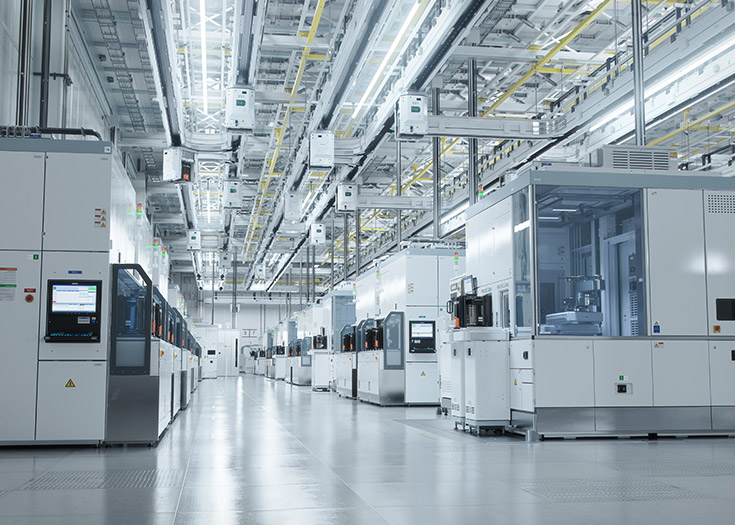
Introduction
Vacuum technology, including vacuum pumps, vacuum filtration components, and other auxiliary equipment required to build a complete vacuum system are crucial for semiconductor, microelectronic, and solar cell-related production processes. Each of these manufacturing processes has the potential to create by-products ranging from silicon particles to chemical vapors. When not addressed, these contaminants can negatively impact overall system performance and destroy critical system components, including vacuum pumps. Filtration solutions designed for the unique requirements of semiconductor and solar cell production help maximize Overall Equipment Effectiveness (OEE) by capturing process contamination, protecting the vacuum pump, reducing maintenance costs, and maximizing semiconductor tool uptime and product yields.
Crystal Growing Vacuum Furnace
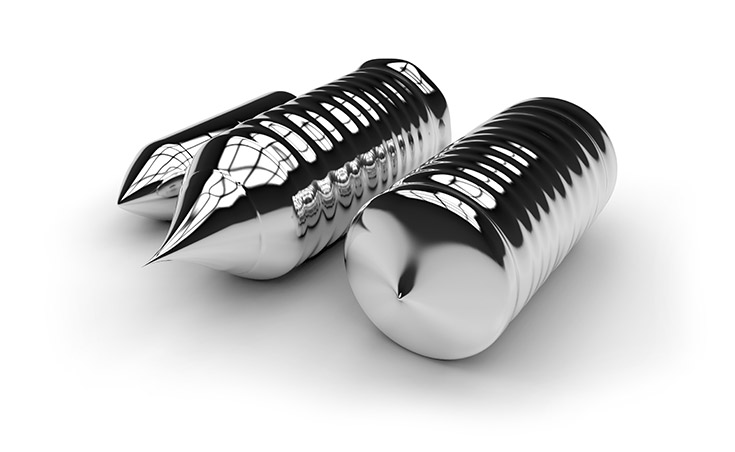 (Example of Monocrystalline Ingots)
(Example of Monocrystalline Ingots)
The manufacturing processes for solar cell manufacturing, flat panel displays, and other semiconductors and microelectronics begin with a silicon ingot. Ingots are produced using vacuum furnaces and have two types: Monocrystalline and Polycrystalline. The solid ingots are then sliced into thin wafers, which become the substrate for microelectronic devices.
Monocrystalline ingots are grown in a vacuum furnace, typically using a production technique called the CZOCHRALSKI (CZ) Method. Monocrystalline ingots are grown from a seed or single crystal of silicon, where the ingot takes on the structure of the seed crystal. This structure results in better electricity flow and improved efficiency from the resulting wafers. These are premium-priced items in the marketplace.
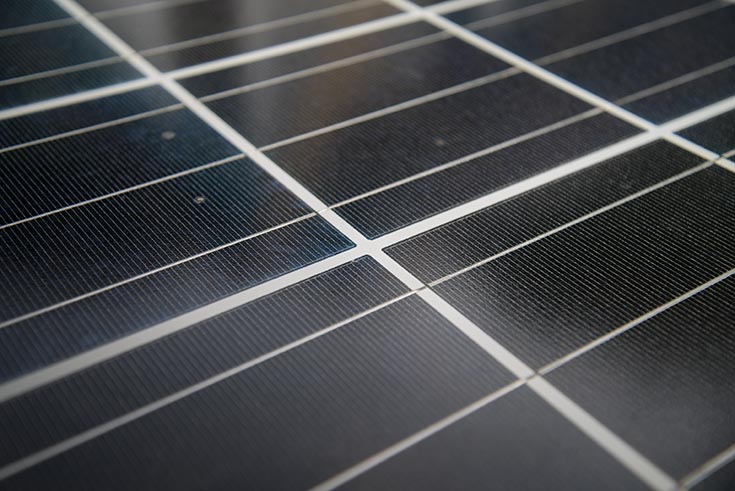
(Example of Monocrystalline Panel)
Polycrystalline ingots are made from multiple silicon fragments. Although common, wafers made from these ingots are considered to have lower efficiency and lower cost in the marketplace.
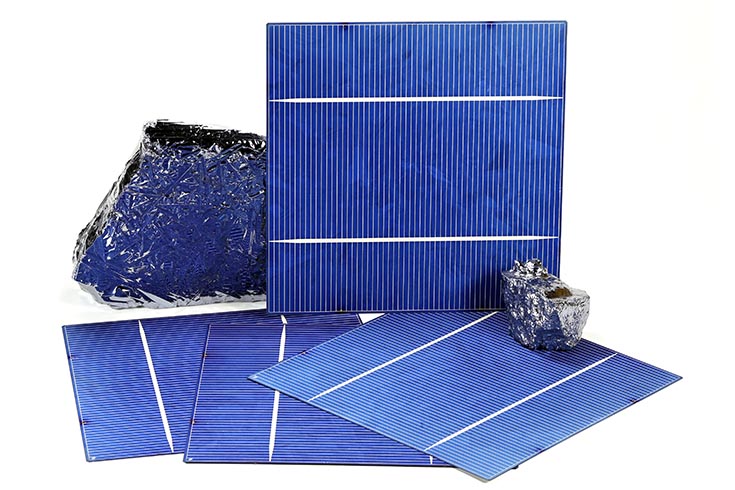 (Example of Polycrystalline Wafers)
(Example of Polycrystalline Wafers)
During the ingot production process, heavy loads of silicon dust carry over from the furnace to the downstream vacuum pump. Monocrystalline ingot production produces the most extreme dust loads. Often, the process produces pyrophoric by-products, which adds a layer of complexity when trying to capture it with a filter. Without an inlet filter for protection, the vacuum pump will become contaminated and fail prematurely, which results in reduced product yields and increased maintenance costs.
Vacuum furnace manufacturers and vacuum pump OEMs only sometimes include filtration in their scope of supply. Inadequate filtration can result in poor equipment performance and cause operational inefficiencies. Negative impacts can include decreased crystal growing yields, pump contamination/failure, production downtime, and excessive overhaul costs. Well-designed inlet vacuum filters that manage the dust load can extend a plant-specific production cycle to over 400 hours in some cases. A purpose-built filtration solution minimizes the pressure drop and allows for continuous and consistent vacuum performance during the build cycle.
Vacuum Filtration Solutions
Pulse Cleaning Inlet Vacuum Filter: This is ideal for continuous duty applications in which frequent manual service is not feasible.
- Given the abrasive nature of the silicon dust, it is important to have the protection of a high-efficiency filter upstream of the vacuum pump.
- Given the harsh and potentially hazardous nature of the silicon dust, Operators prefer to limit the handling of their filters. For example, the integrated self-cleaning pulse feature of filters, like the Solberg RX Series, allows for cleaning without direct contact. These filters operate in conjunction with plant-supplied compressed inert gas (Argon, Nitrogen) or dry compressed air to pulse clean the internal cartridges in between build cycles. This feature extends the filter element's service interval and limits the operators' physical handling and exposure.
- An internal filter cartridge manufactured with high-efficiency PTFE media (99.5%) offers the best dust release properties when pulsed.
- Pulse controls, isolation valves, air/gas accumulator tanks, and removable collection containers are turnkey options that allow the operator to “plug and play.”
- Various construction materials (carbon steel, stainless steel, etc.) are recommended based on the application conditions and site-specific requirements.
- The availability of various connection types (DN Flanges, ANSI Flanges, ISOK Flanges) and piping configurations (angled, straight through, tangential, etc.) is important to best match the process piping and vacuum pump inlet connection.
- The filter design depends on specific process details, including charge weight, dust challenge (kg/hr), micron size, cycle time, and process flow rate. Sizing is important to ensure there is adequate filtration surface area for long life and increased conductance/decreased pressure drop.
Heavy Duty Inlet Vacuum Filter:
- For applications in which pulse cleaning is not feasible. A high-efficiency inlet vacuum filtration solution is critical to protecting the pump and allowing for continuous duty. The Solberg WL Series is an example of a purpose-built filter for these applications.
- The internal cartridge and filtration media micron rating and efficiency are selected based on the specific operating conditions. Filtration options include PTFE (99.5% efficiency for 0.3 microns), High-Efficiency Stainless Mesh (various available micron sizes and efficiencies and Polyester (99+% for 5 micron or 1 micron dust)
- Leak rate is a critical consideration to help maintain the desired continuous vacuum. Leak rates of 1X10-5 mbar liters/second or better are essential to ensure performance integrity under medium to high vacuum conditions.
- Ports are recommended to allow operators to oxidize unreacted dust prior to service and cleaning. When reacted with oxygen (oxidized), silicon dioxide SiO2 is created, which allows for safe disposal.
- Various materials of construction (carbon steel, stainless steel, etc..) and connection types (DN Flanges, ANSI Flanges, and ISO K Flanges) are considered depending on the process piping and vacuum pump connections.
- Routine service will include cleaning and eventually replacing the internal filter element(s).
By protecting the vacuum equipment from silicon dust with an engineered inlet filtration solution, the Operator will achieve longer pump service intervals and reduced maintenance costs. Operators will experience increased production up-time and more consistent process vacuum leading to higher ingot yields and improved ingot quality.
Inert Purge Gas Recovery and Recycling
Argon is used as a purge gas within the vacuum furnace during the ingot production process to remove contaminants and prevent unwanted reactions with silicon. Given Argon's high price and relative scarcity, ingot manufacturers (LONGI, Panasonic, AUO, etc.) attempt to recover and recycle. The evacuated gas is contaminated with silicon dust. As mentioned in the crystal growing section above, without an inlet vacuum filter, the downstream vacuum pump will be contaminated. Furthermore, dust carryover through the pump exhaust will damage the sensitive downstream argon recovery and reconditioning equipment. As previously detailed, high-efficiency filtration solutions are necessary between the crystal growing furnace and the vacuum pump and, in some cases, between the pump exhaust and the Argon recovery system.
Vacuum Filtration Solutions
As mentioned in the crystal growing section above, a heavy-duty and high-efficiency filtration solution is critical for capturing the silicon dust carryover from the vacuum furnace. Depending on the exact process conditions, inlet vacuum filters like Solberg’s WL Series for medium to heavy contaminant loads or RX Series pulse cleaning functionality for heavier contaminant loads offer high levels of protection for vacuum pump systems.
Additionally, oil mist coalescing technology is necessary to capture oily emissions vented from oil-sealed vacuum pumps installed upstream of the sensitive argon recovery equipment. Wet and dry vacuum pump technologies are used in this industry, and both technologies have advantages and disadvantages. When oil-sealed vacuum pumps are deployed, in addition to inlet filtration, oil mist exhaust filters offer a high-efficiency air-oil separation (99.97% for 0.3 micron oil mist) to give Operators the confidence to install oil-lubricated vacuum pump technologies in their facilities.
What is Chemical Vapor Deposition (CVD)?
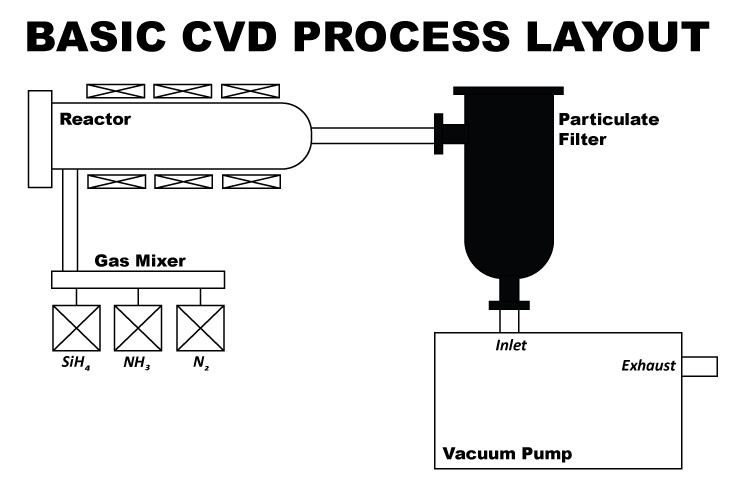
Silicon ingots are cut into wafers used to manufacture a solar cell, flat panel display, or other semiconductors. The next step is to deposit a durable thin film surface silicon or metal-based material for improved insulation and conductivity. This is known as Chemical Vapor Deposition (CVD), which is a critical process within any wafer fab.
Precursor gases are injected into a heated vacuum chamber, and the resulting reaction and decomposition create the film deposited on a silicon wafer substrate. The deposited layer is also used for encapsulation to prevent oxidization/corrosion. There are several types of CVD, which are distinguished by chemistry and the resulting reaction. The following are the most common deposition processes:
- CVD: Chemical Vapor Deposition
- PECVD: Plasma Enhanced Vapor Deposition
- HDPCVD: High-Density Plasma Chemical Vapor Deposition
- MOCVD: Metal Organic Chemical Vapor Deposition
- ALD: Atomic Layer Deposition
The different chemistry for each deposition process creates filtration challenges because the deposited materials are varied (silicon dioxide, silicon nitride, gallium nitride, aluminum oxide, etc.). Since the deposition process is carried out under vacuum conditions, vacuum pump protection is critical.
Vacuum Filtration Solutions
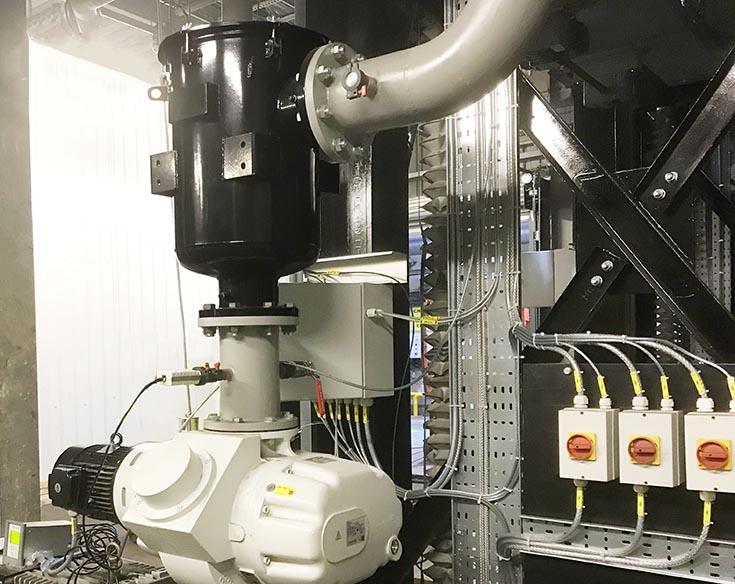
A common misconception is that dry vacuum pump technologies do not need filtration for optimal performance. However, field experience confirms that when filtration is excluded, the results are unsatisfactory process conditions, pump contamination, reduced vacuum pump performance, expensive overhauls, reduced product quality, and diminished yields. The best practice is to analyze specific process conditions and design vacuum filtration systems that will capture contaminants while allowing for ideal vacuum performance during production cycles. The forementioned high-efficiency dust filtration solutions (WL Series) or pulse cleaning (RX Series) are viable based on the specific process conditions. In vapor deposition applications, there is also potential for contamination in vapor form depending on the process chemistry. Vapor condensing vacuum filtration solutions must be considered to protect the downstream vacuum pump to reduce tool-down time and increase wafer quality and yields. Condensing solutions such as the Solberg JRS Series are discussed in further detail within the lamination section below.
Solar Panel Lamination
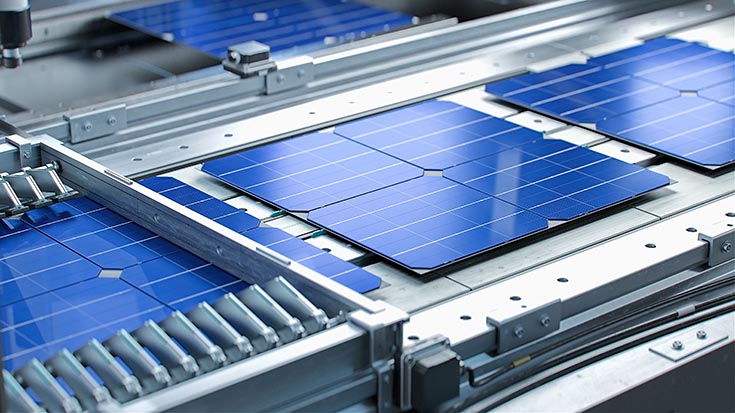
(Example of a Solar Cell Production Process)
Once the solar cell module is complete, a final glass lamination/glass coating is applied to prevent environmental contamination (moisture/dirt penetration). Contamination limits the conductive efficiency, so the lamination step is critical to the final performance. Ethyl Vinyl Acetate (EVA) is the most common compound because of its adhesive and optical qualities. The glass lamination process is performed under vacuum conditions to ensure that air, water vapor, or other impurities are not trapped against the surface.
Based on the operating temperature and operating vacuum level, EVA flows downstream to the vacuum pump in vapor form and sometimes droplet form. Condensing is the most effective method to capture the vapor and protect the vacuum pump. Process variables such as vacuum level, temperature, and vapor pressure require a technical partnership between equipment operators, tool manufacturers, vacuum pump suppliers, and filtration specialists. Collaboration and knowledge sharing are essential during the requirements planning stage to define an agreement on desired outcomes, as it will help ensure an effective solution is deployed.
Vacuum Filtration Solutions
Vapor Condensing Filters:
- Vapor condensing under vacuum conditions is challenging due to a drastically reduced EVA boiling point.
- To condense vapors, an available chilled fluid utility is a prerequisite via an industrial chiller. The required fluid temperature is dependent on the specific process conditions.
- A multi-stage condensing filter, such as Solberg’s JRS Series, operates in conjunction with the plant-supplied chilled fluid source (glycol, chilled water) to create a cold surface for condensing vapors.
- The internal cooling surface of the JRS is a proprietary stainless steel pleated pack designed to maximize surface area, surpassing the performance of traditional cooling coil designs. With appropriate sizing, the cooling surface dwell time is maximized, enhancing the condensing performance.
- Multiple filtration stages will boost filtration efficiency, so stainless steel demister pads are a common second stage for separating fugitive condensed droplets, and final adsorptive filter elements are ideal for capturing residual vapors.
- Various materials of construction (carbon steel, stainless steel, etc. and connection types (DN Flanges, ANSI Flanges, ISOK Flanges) must be considered to handle the process conditions and fit within the available space on or near the vacuum pumps.
Conclusion
Depending on the specific semiconductor or solar applications, vacuum process contamination takes various forms. Wafer fab Owners/Operators make large investments in tools, vacuum pumps, and ancillary systems. However, protecting the integrated vacuum pumps has mistakenly been viewed as detrimental to performance.
Solberg’s industry partners and customers have given us a clear understanding of the various process conditions, and proven filtration solutions have created Win-Win outcomes worldwide. We provide technical advice to tool and equipment manufacturing leaders, vacuum pump OEMs, service companies, and strategic end-users to demonstrate how high-efficiency filtration maximizes vacuum equipment uptime and product yields while reducing costly overhauls and service.